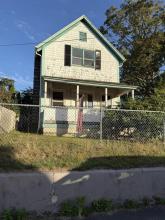Report estimates $550k to stabilize Tremont Nail for development
Some Wareham residents consider it an opportunity, others a white elephant. But an independent report on the Tremont Nail Factory recommends that - like it or not - the site requires a projected $557,280 to be stabilized before its future can be addressed.
The June 2009 report by the Menders, Torrey and Spencer Inc. architecture firm in Boston was commissioned for $50,000 by the Community Preservation Committee (CPC) and the Board of Selectmen to assess the Tremont Nail Factory site's current condition and possible options for its further use. The report's scope, and the detail to which it examines each of the 8 buildings on the 7.2-acre site, demonstrate the complexity facing the future of the property.
"There are some challenging elements to the site," admitted Lynne Spencer, the lead author of the study. She specifically cited a water trough in the factory building that collects water seeping through the wall bordering Elm Street and was used to power machinery. "[The trough] was once instrumental to the factory as its source of power, now it offers a vulnerability," she said, explaining that an open trough of water in the basement of an old building could produce mold and other problems. "But it's part of the beauty of the site, it will attract people there."
The study's goal, Spencer says, was to approach the site with "grounded realism" and explore options for adaptive reuse of the site. Some options investigated by the study include developing what architects and planners call a festival marketplace - essentially using the site to shelter low-impact activities such as craft fairs or a farmer's market where vendors bring in kiosks - housing, and light industry. Each of these options would have to meet three criteria: honoring and celebrating the historic significance of the site; familiarizing users with the site so they can learn its value; and contributing revenue to the site for its maintenance and future development.
The first step, however, is to stabilize the buildings so that a developer can come and apply these ideas.
Architect Patrick Guthrie described the stabilization process as "we want to take the buildings to the point where you don't have to replace it, you have to maintain it."
"We want to stabilize the site so that we can have some creative things going on," explained Nancy Miller, chair of the Community Preservation Committee, the group that allocated the Community Preservation Act (CPA) funds to purchase the site for the Town of Wareham in 2004. "We're looking for a perfect blend of preservation and profit."
Three buildings were classified by the report as essential to retain.
- The circa-1846 factory building is the most urgent priority, as it is the oldest, most meaningful and architecturally significant feature at the site. The nearly 20,000 square-foot building also still contains machines and tools. However, it is estimated to require $218,000 to seal the envelope of the building from the weather by re-shingling the roof, reinforcing the main beams and repairing the windows and trim.
- The freight building along the banks of the Wankinco River, which was built in 1848 to receive and ship materials traveling by water, is considered the second most historically significant building. It is structurally solid, but the building requires $229,590 to be stabilized, most of the costs being dedicated to re-roofing and re-shingling. With a public kayak landing nearby, the report suggests that the building be immediately used as seasonal storage or to host a concession stand to generate revenue.
- The office building, constructed around 1800, is a crucial example of the business side of the factory. The report recommends completing an inventory of the interior furnishings, completing a structural analysis of the second floor to evaluate possible office uses, as well as removing the evidence of a 1970s renovation and the vinyl siding and shutters to restore the building to its original appearance.
The report says that the other four buildings on the site may be retained or removed after they are stabilized.
- The 1896 Pickling building has been so altered that the report recommends spending $15,650 to stabilize the building before another $14,000 so that it can be removed and its timber retained for reconstruction elsewhere on the site. Reconstructing the building would cost an additional $217,500.
- The Packaging building (1957) could serve multiple uses in the future. To stabilize it to bring in revenue as storage space would require $25,940.
- The Freight Shed (circa 1900) represents the southernmost extent of the factory site and will cost $17,500 to stabilize. Because it lies in a floodplain (where existing buildings can be renovated but new construction is prohibited), it may be a key part of future renovation.
- The Restroom building (1953) would cost $12,000 to stabilize.
The report recommends eventually removing the site's most recent building, the steel building constructed in 1976, but recognizes that it currently provides a revenue source for the town.
But the funds to complete the stabilization will be difficult to come by in the current economy. The Community Preservation Act is funded by a 3-percent surcharge on the assessed value of property and a surcharge on real-estate transactions. Both property values and the frequency of real-estate transactions have decreased with the economy. Furthermore, while Massachusetts provided a 100-percent match of town funds when the legislation began in 2000, the State match has decreased to approximately 30 percent today, said Miller. Finally, the CPC is receiving many more requests for funds as other revenue sources dry up.
So the groups interested in preserving and redeveloping Tremont Nail are trying to determine how to make the site most attractive to private, but historically respectful, development. The group is partnering with Preservation Mass, a historical preservation nonprofit, to develop a Request for Proposal that entices private development while restricting the site to appropriate uses. Preservation Mass would also enforce any restrictions on the property.
The group will also be looking at revenue streams - whether from stabilizing the site and introducing new sources of income, grant money, or other sources - to begin work on the project.
Although architect Guthrie said there was no "sell-by date" for buildings, he and Spencer both said that the sooner the buildings are stabilized, the less money they will require for future renovations.
Meanwhile, everybody will keep the idea of "grounded optimism" in mind.
"I just haven't seen a similar project that demonstrates it's feasible to totally renovate the site," said Chris Reilly, director of the Community Economic Development Authority in Wareham that has been touring the site with developers and working with the CPC and the town on the project. However, Reilly is agreeable to the idea of renovating one building, or a portion of a building, and renting that out for offices or a small crafts shop to bring in revenue that could be used toward the site's eventual renovation. "Using a portion of the site to bring in revenue for eventual work? That's a discussion we need to have."










